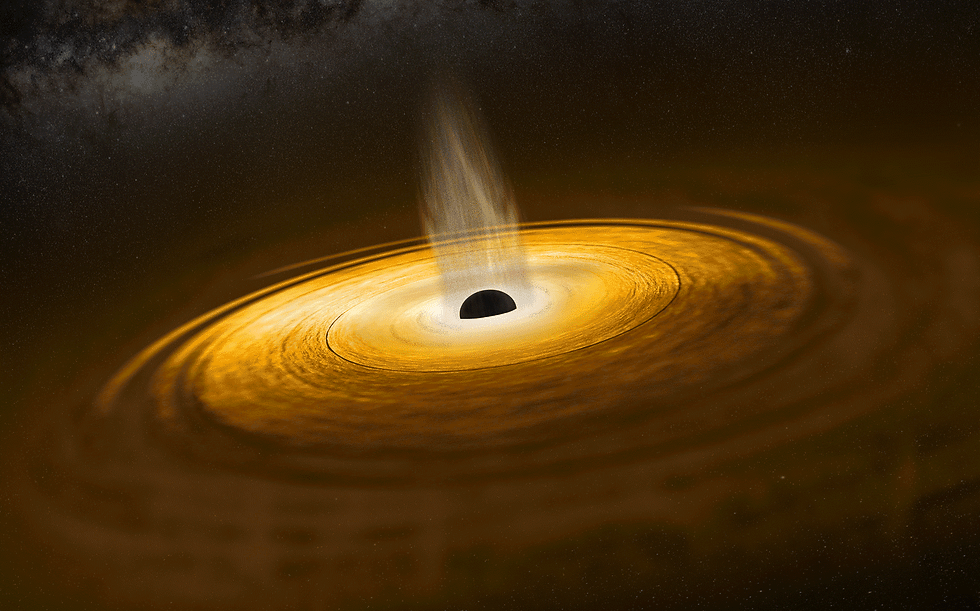A mysterious monster (Choose your own Star Part 6)*
- Perdita Moon

- Sep 9, 2022
- 4 min read
Your massive star is gone in a supernova explosion, replaced by something much more intriguing... and dark.
*This series of posts are an homage to the Choose your own adventure book series, which my Earthling alter-ego so much enjoyed in her youth.


A black hole in action. Credit: ESA
So your 30-solar-mass star exploded as supernova. Apparently, nothing is left. Or at least, you don't see anything where the star used to be. Still, you can feel it... The Force (of gravity, for sure). Even stronger than before.
Yet, no matter how you look at it, all you can see is indescribable darkness... You suspect that the Force is so strong that even light gets trapped inside that black abyss. Your whole star must have collapsed into a dot of infinite density. A situation like no one can imagine, for there is no Physics capable of describing what is going on within it. A real singularity of space and time. Your star has gone into the dark side indeed!
Anatomy of a monster
You monitor that black hole your star has turned into from a distance, careful not to get too close to the dark sphere at the centre. Given that you cannot get any information from inside, you decide to call the surface of that sphere "event horizon".

Structure of your black hole. Credit: ESO, ESA/Hubble, M. Kornmesser & N. Bartmann
Anything falling towards that ball of darkness gets extremely stretched due to the rapidly increasing intensity of the gravitational field. Even from your (relatively safe) location, you notice how the parts of your body closer to the black hole are feeling a remarkably stronger pull than those located farther away. Matter is also being compressed and squeezed, as though it were forced to get through a pipe that is getting narrower and narrower the more the object approaches the event horizon. This completely tears things apart, heating them up, and emitting a lot of radiation in the process. As a consequence, a spinning disk has formed. The matter is slowly spiraling toward the central singularity, feeding the dark monster, which is increasing its mass and becoming even more powerful.
The black hole itself must be spinning, too, although you find it hard to picture how a simple dimensionless dot can do such a thing. However, the sign is unmistakeable: From time to time, the monster is launching two jets of gas. This can only mean that the mass increase has caused it to rotate too fast, and needs to release some of the matter to get back to a safe spin rate.
Relatively weird
You entertain yourself by throwing things –a rock, a spacecraft, a little star...– into the black hole and watching what happens. It's funny: You never actually see things crossing the event horizon. As they get close, things seem to slow down more and more, forever approaching the point of no return, but without ever reaching it. Caught by sudden inspiration, you throw a watch and gaze at it in awe: Time is indeed ticking more and more slowly as the watch falls!
Simulation of the accretion disk around a black hole, showing how gravity distorts our view. Due to the disk's rotation, the gas that is moving towards you appears brighter than the one that is moving away, Credit: NASA’s Goddard Space Flight Center/Jeremy Schnittman. More information on this page.
Light is also behaving weirdly in the vicinity of the monster. For one thing, it is becoming redder and redder as it gets closer to the event horizon. You figure out this is caused by the effort not to fall onto the black hole, for you know that red light is less energetic than blue light.
Besides that, light rays are bent like a gum strip, creating surprising optical illusions. For example, you can see the back part of the disk as though it were wrapping the dark central sphere. You are also able to see things that are located well beyond it; it looks as though the black hole is acting as a lens, focusing the light rays that otherwise would have got spread into space. You feel a bit dizzy about this: Sometimes, you see double or multiple images of the same object!

An illustration of the image of a star behind a black hole getting split into two as seen by a telescope on the other side. Credit: NASA/Roman Space Telescope
Waiting to evaporate
You start wondering how long this amazing situation will last. For all you know, your black hole could live forever! However, some Google search tells you that this may not be the case: According to some experts, black holes must lose some energy (otherwise, they would contradict the laws of Quantum Physics) and will eventually steam away, although this would certainly take ages...
And that is supposing the central singularity is not refilled by eating matter from outside. Anyhow, it looks like you must learn to live with your black hole for a long, long time...




Comments